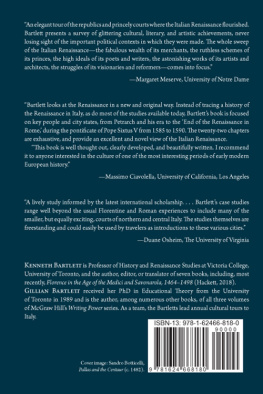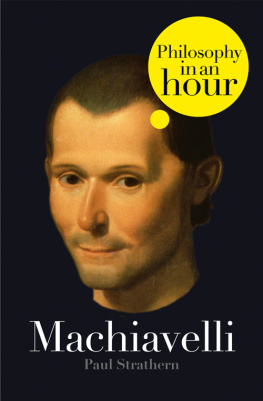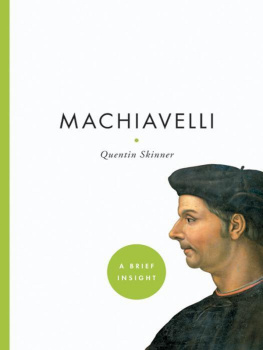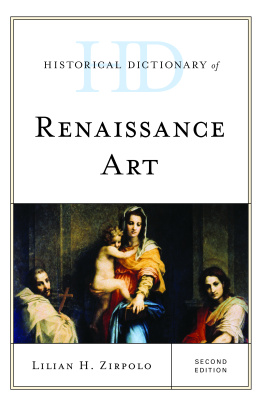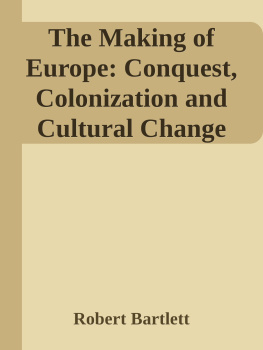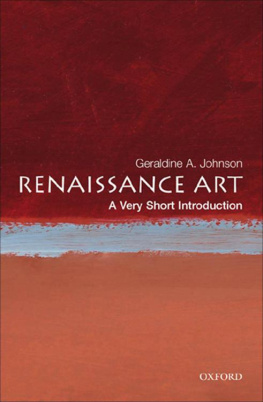CONTENTS
the
RENAISSANCE
in ITALY
A History

the
RENAISSANCE
in ITALY
A History

Kenneth R. Bartlett
with Gillian C. Bartlett
Hackett Publishing Company, Inc.
Indianapolis/Cambridge
Copyright 2019 by Hackett Publishing Company, Inc.
All rights reserved
Printed in the United States of America
22 21 20 19 1 2 3 4 5 6 7
For further information, please address
Hackett Publishing Company, Inc.
P.O. Box 44937
Indianapolis, Indiana 46244-0937
www.hackettpublishing.com
Cover design by E.L. Wilson
Interior design by Laura Clark
Composition by Aptara, Inc.
Library of Congress Cataloging-in-Publication Data
Names: Bartlett, Kenneth R., author. | Bartlett, Gillian C.
Title: The Renaissance in Italy : a history / Kenneth R. Bartlett, with Gillian C. Bartlett.
Description: Indianapolis : Hackett Publishing Company, Inc., [2019] | Includes bibliographical references and index.
Identifiers: LCCN 2019010480 | ISBN 9781624668180 (pbk.) | ISBN 9781624668197 (cloth)
Subjects: LCSH: RenaissanceItaly. | ItalyHistory14921559Biography. | ItalyHistory12681492Biography.
Classification: LCC DG533 .B29 2019 | DDC 945/.05dc23
LC record available at https://lccn.loc.gov/2019010480
epub3 ISBN: 978-1-62466-871-5
Kenneth Bartlett, Florence in the Age of the Medici and Savonarola, 1464-1498: A Short History with Documents .
Petrarch, The Essential Petrarch . Edited and Translated, with an Introduction, by Peter Hainsworth.
Pico della Mirandola, On the Dignity of Man . Translations by Charles Glenn Wallis, Paul J. W. Miller, and Douglas Carmichael. Introduction by Paul J. W. Miller.
Renaissance Humanism: An Anthology of Sources . Edited and Translated, with an Introduction, by Margaret L. King.
Acknowledgments
Those who travel with us to Italy, comment on our video series, and attend our public lectures inspired us to produce a comprehensive but approachable assessment of the Italian Renaissance. This book was long in the making and consequently benefitted from the assistance and encouragement of many others, too numerous to thank individually but nevertheless greatly appreciated.
Our editor at Hackett, Rick Todhunter, deserves our sincere gratitude. His enthusiasm for the project and his appreciation of the special nature of this book provided the encouragement needed to complete such an ambitious task. His colleagues Laura Clark and Liz Wilson proved generously flexible in their production schedule, and their careful reading of the manuscript caught many errors and inconsistencies. Any imperfections that remain are ours alone.
We would also like to recognize the financial support of the Research Committee of Victoria College in the University of Toronto. The constant support and generous grant allowed us to produce a better and more accessible text.
Finally, we would like to dedicate the book to the memory of our mother and mother-in-law, Ethel Edith Cavell Bartlett (19172018), who passed away while we were engaged in this project. Her love of books, reading, and travel, and her respect for education and the power of words always served as an inspiration.
Kenneth and Gillian Bartlett
Toronto, March 2019
{vii} Contents
The page numbers in curly braces {} correspond to the print edition of this title.
{xiii}
The Italian Renaissance has come to occupy an almost mythical place in the imaginations of those who appreciate history, art, or remarkable personalities. Many of the figures who lived in that period are themselves the subject of biographies and narratives that border on hagiography. Michelangelo, Niccol Machiavelli, Lorenzo the Magnificent, Pope Julius IIthese and so many others engender a kind of wonder: How could so many geniuses or exceptional characters be produced by one small territory near the extreme south of Europe at a moment when much of the rest of the continent still labored under the restrictions of the Middle Ages?
This popular understanding of the Italian Renaissance traces its origins as far back as the mid-sixteenth century when Giorgio Vasari wrote of the Rinascita (Rebirth) in his Lives of the Artists (1550), a series of biographies that describe an ascent of artistic genius from first lights to the divinity of Michelangelo. In France, Voltaire, foe of the priesthood and luminary of the Enlightenment, praised what he saw as the growing secularism of the Renaissance. The historian Jules Michelet gave us the standard French word to define the period in his monumental History of France (1855), characterizing it as a time when society moved away from obscurantist theocracy and monarchism to what he saw as a more enlightened, secular, and progressive era. But it was the nineteenth-century Swiss art historian Jacob Burckhardt, in his Civilization of the Renaissance in Italy (1860), who reinforced not only this concept of profound change but also made the significant claim that somehow the Italian Renaissance was the birth of modernity.
Each of these writers can be seen to be channeling for his own present. Vasari, propagandist for the Medici grand dukes that he was, sought to exalt Florentine art and artists to the highest level of perfection. Voltaires praise of the Renaissance came not so much from a judgment on those historic years themselves as from his personal proscription of the ancien rgime, that union of throne and altar that he so deplored. Michelet was seeing encouraging parallels with the rise of mid-nineteenth-century anticlericalism and liberalism. Burckhardt chafed under the moral and social strictures of his deeply Protestant, bourgeois Basel.
The Italian Renaissance, then, was in many ways an entre into reflections on the contemporary values and hopes of the historians who investigated the period. It became a vehicle for putting contemporary times in context. And so, like these earlier historians, we ask the same questions. Where do so many of the driving principles behind our current Western civilization come from? How did they emerge and how were they defined and developed so that we might use them as tools to unlock our own present and project the future? And to frame the discussion in personalities: Why is it that geniuses such {xiv} as Leonardo, Raphael, Petrarch, Brunelleschi, Bramante, and Palladio all sustain their towering authority to this day?
This book will reinforce the contention that individuals with access to wealth and power can have a profound influence. They matter. And this explains why the Italian Renaissance is often perceived as elitist. Those who commissioned the works of art, often those who produced them, and many of those who appreciated them were privileged, educated, influential members of the Renaissance one percent. This is meant in no way to denigrate modern interest in the poor and the marginalized, but merely to say that the enduring ideas and artifacts of the Renaissance arose from a highly rarefied world of sophisticated talent and thought galvanized by individual curiosity and accomplished with practiced skill. And so it is that this book will be an exploration of the Italian Renaissance guided by particular moments and menand a few remarkable women. It will be a large canvas with broad strokes intended to be seen at a distance for the dynamic sweep of its narrative of ideas and creative genius.
Nevertheless, these individuals must be viewed within their social and economic contexts. Petrarch could not have written without the support of powerful political patrons and the Church. Bruni could not have become the voice of Florentine republican liberty if there were not a great many citizens who believed in such freedom. And Isabella dEste could not have acquired the reputation of la prima donna del mondo the first lady of the worldif she had not exemplified the qualities valued by her age.

